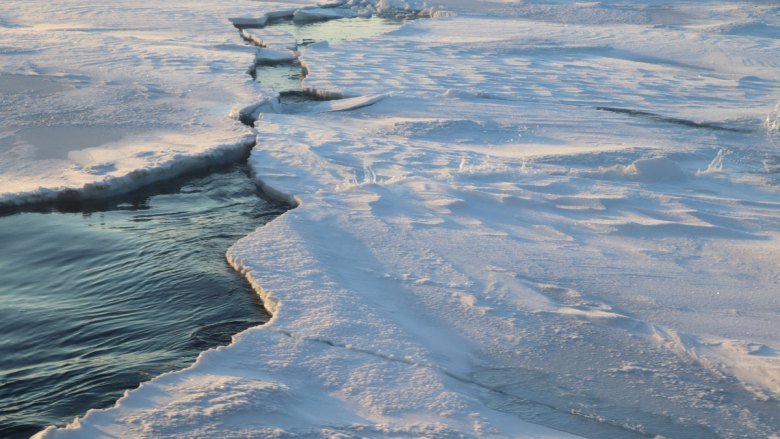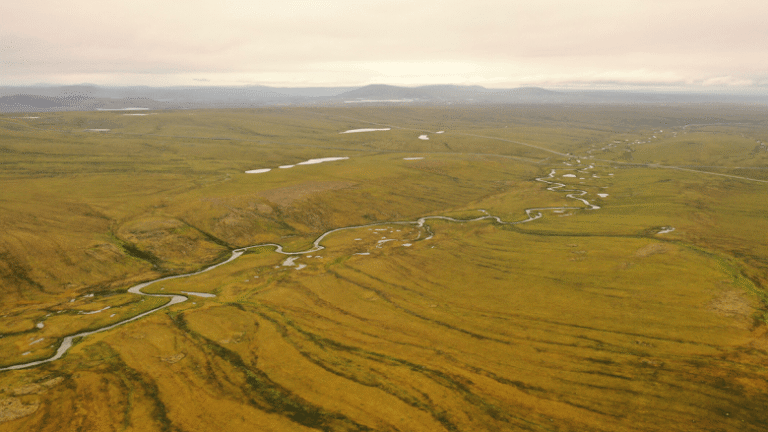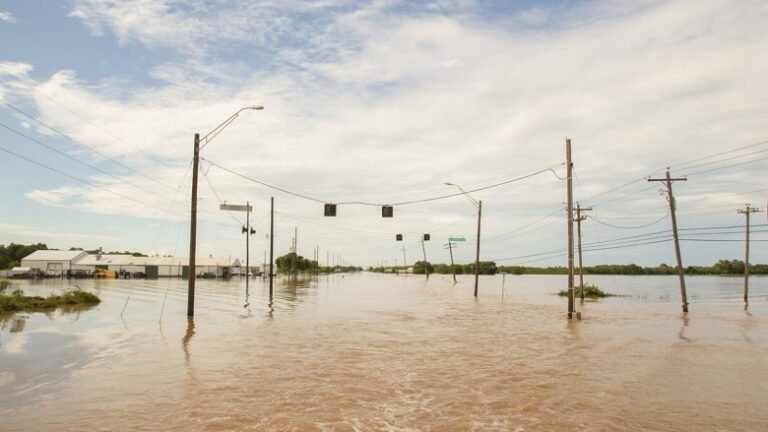

The Arctic is experiencing the most rapid climate change on Earth as average temperatures there rise up to 4 times faster than on the rest of the planet. Among the many environmental effects of this warming, the Arctic Ocean, critically, is moving toward a “blue” state, meaning it is increasingly becoming ice free during the summer months.
This shift raises significant concerns about the region’s future. Arctic Indigenous peoples, for instance, heavily rely on stable ice conditions for traditional hunting, fishing, and travel. As ice disappears, these activities become more dangerous or impossible, threatening food security, cultural practices, and the transmission of Traditional Knowledge. Global geopolitical and economic pressures will also rise as new shipping routes open, previously inaccessible resources become available for extraction, and international competition over these resources rises.
Currently, scientists struggle to predict how an ice-free Arctic will react to and amplify a warmer global climate.
Currently, however, scientists struggle to predict how an ice-free Arctic will react to and amplify a warmer global climate. The lack of clear climate projections for the region is largely due to a shortage of key geological data describing former climatic conditions and how the Arctic has responded to past changes, as well as to difficulties interpreting the records we do have. Making sense of these data is essential for understanding how the Arctic will evolve in the coming decades.
Deep-sea sediment cores provide some of the best available archives from the Arctic Ocean. These cores, drilled and collected from sites around the region, contain sediments deposited over hundreds of thousands of years that offer clues about past ocean temperatures, sea ice and ice sheets, and ocean circulation changes. To gain insights specifically into how the Arctic may respond to future warming—and the broader implications for the planet—scientists focus on past “greenhouse” states, when Earth’s climate was warmer than it is today, such as the Last Interglacial, about 130,000 years ago.

However, reconstructing past warm climates from deep-sea core records is challenging, particularly because the chronology of Arctic Ocean sediments has been difficult to establish. The lack of biological remains and the dissolution of calcium carbonate in these sediments complicate efforts to determine their ages (i.e., their chronostratigraphy). Furthermore, the use of different dating methods and uncertainties about sedimentation rates have led to conflicting interpretations of core records and hindered the development of a solid timeline for Arctic climate history [e.g., Stein et al., 2025].
Recent advances in research have raised questions about the accuracy of prior published ages of Arctic Ocean sediments. These developments have also highlighted ongoing uncertainties and the need to understand the abilities and limitations of different dating tools. Without this understanding, it will be difficult to identify and detail past greenhouse climates with confidence, which in turn, will limit our ability to apply knowledge of these past conditions to inform climate models.
The Arctic Ocean Stratigraphic Toolbox
In fall 2024, more than 40 scientists gathered at the ArcSTRAT conference in Tromsø, Norway, to discuss the latest research and how available methods can best be used to develop a reliable chronostratigraphic framework, or age model, for Arctic sediments. Additional goals were to foster shared understanding of the region’s climate history and to improve our ability to provide accurate data to climate modelers.
A key challenge in studying Arctic paleoclimate is that oceanic sedimentation rates are typically low across the region.
A key challenge in studying Arctic paleoclimate is that oceanic sedimentation rates are typically low across the region. In fact, the central Arctic Ocean is one of the slowest accumulating marine sedimentary environments globally because of limited sediment sources and biological productivity, suppression of sediment transport by sea ice, and sediment trapping on broad circum-Arctic continental shelves.
The slow sediment accumulation results in thin sediment layers that can make it difficult to obtain clear chronological data. Dissolution of calcium carbonate from deposited sediments, which can occur where deep seawater is undersaturated with respect to the mineral, further reduces the possibility of finding datable microfossils in the sedimentary record.
In some areas, biostratigraphy (the distribution of ancient life in sedimentary rocks) and stable isotope geochronology (which compares ratios of nonradioactive isotopes of, e.g., carbon or oxygen) can be used to refine age models. In other areas, alternative methods are needed to provide age constraints. Such methods include magnetostratigraphy, which dates sediment layers by correlating their magnetism to the record of Earth’s magnetic field reversals; amino acid racemization, which measures the time-dependent breakdown of proteins in fossils too old for radiocarbon dating; luminescence dating, which measures radiation that builds up in materials as they age; and radionuclide dating.

Recent breakthroughs, particularly in applying radionuclide methods, have shown promise in improving the accuracy of Arctic Ocean sediment age models (Figure 1). For example, novel applications of uranium series isotopes (e.g., thorium-230 and protactinium-231) have been used to propose new age constraints for marine sediment sequences from important topographic regions, such as the Mendeleev-Alpha and Lomonosov Ridges, where low sedimentation and poor preservation of fossil material have hampered previous attempts to date these sequences [Hillaire-Marcel et al., 2017]. These isotopes decay predictably over time, allowing scientists to date past interglacial periods more confidently, including the Last Interglacial and others occurring around 200,000 years ago.
These new radionuclide-based age constraints are supported in part by recent applications of more traditional dating methods like biostratigraphy. Specifically, a newly revised Arctic sediment chronology for the late Pleistocene (400,000–10,000 years ago) established on the basis of analyses of calcareous nanoplankton, although not perfectly aligned, showed less uncertainty in the identification of interglacial periods in the central Arctic Ocean [Razmjooei et al., 2023]. Tracking changes in the concentration of cosmogenic radionuclides, like beryllium-10, in Arctic sediments has also provided new insights into the timing of interglacials [Spielhagen et al., 1997].
The Need for a Multimethod Approach
Some methods are better suited than others for studying sediments from given locations because environmental conditions across the Arctic differ.
The generally low sedimentation rates across the Arctic Ocean produce thin sediment layers that require precise sampling and, because not every dating method works well everywhere, careful selection of analytical methods. Some methods are better suited than others for studying sediments from given locations because environmental conditions across the Arctic differ, contributing to variable sedimentation rates, variable preservation of fossils, and disturbances like erosion and bioturbation (the reworking of sediment layers by living organisms).
Whereas relying on a single method to study sediments from across the Arctic Ocean may lead to inaccuracies and gaps in understanding, different methods can complement each other, providing a fuller, more robust picture of the past. Discussions during the ArcSTRAT conference highlighted the importance of using a multimethod approach, combining the various available stratigraphic and isotopic dating methods.
The challenge lies in carefully selecting appropriate methods to study cores from different regions to minimize errors and uncertainties and provide a reliable reconstruction of past Arctic environments. In areas where calcium carbonate is well preserved (e.g., topographic highs), for example, biostratigraphy and isotope geochronology are extremely useful. In areas where it is not (e.g., deep basins), litho- and magnetostratigraphy combined with radionuclide dating might be better options.
The past few decades have seen the development and application of a veritable toolbox of different techniques for dating Arctic Ocean sediments. These tools must now be integrated and applied to study newly collected sediment archives.
New Arctic Archives
Alongside methodological developments, new Arctic sediment cores have been retrieved recently, including during the International Ocean Discovery Program’s Expedition 403. In 2024, this campaign successfully drilled more than 5 kilometers of sediment cores from the Fram Strait west of Svalbard that offer a high-resolution record of past Arctic climates [Lucchi et al., 2024].
The scientific aim of this drilling was to better understand the ocean system and cryosphere during past warm intervals and how they relate to high insolation (exposure to sunlight) and atmospheric carbon dioxide levels. This information is essential for comprehending the climatic evolution of the Northern Hemisphere and the dynamics of ice sheets, sea ice, and ocean circulation. Data from these cores will be invaluable for studying the mechanisms that lead to ice-free Arctic summers and for understanding the effects of these conditions within and beyond the Arctic.

In 2025, the European Research Council’s (ERC) Synergy Grant–funded “Into The Blue” (i2B) Arctic expedition aboard R/V Kronprins Haakon will focus on recovering additional unique sediment archives from the central Arctic Ocean. The plan is to use a combination of classical and cutting-edge techniques to explore the Arctic’s climate history as completely as possible, matching the methods to the demands of each core. Together with stratigraphic methods, these techniques include analyses of molecular biomarkers, palynology (the study of preserved pollen grains and spores), ancient DNA, radionuclides, and stable isotopes to reconstruct past sea ice conditions, ocean heat transport, and cryosphere variability during warmer-than-present climate states such as the Last Interglacial.
A Promising Start to the Work Ahead
The ArcSTRAT conference made clear that the work ahead is challenging but promising. The outcomes and consensus about coordinating multimethod approaches will provide a crucial framework for analyzing new cores from the i2B expedition and, hopefully, additional future expeditions. The meeting also helped to establish a forum for continued collaboration and knowledge exchange among Arctic stratigraphy experts—an important step toward resolving continuing disparities among dating methods and developing a robust Arctic Ocean chronostratigraphy.
As the Arctic continues changing at an unprecedented rate and advancing toward blue summers, understanding its past is more critical than ever.
As the Arctic continues changing at an unprecedented rate and advancing toward blue summers, understanding its past is more critical than ever. By piecing together the climatic history of past greenhouse states, scientists are building the foundation for more accurate climate models, which are essential for informing accurate global climate assessments that, in turn, guide policy decisions in countries and communities around the world.
With ongoing advances in the toolbox of techniques for studying ocean sediment stratigraphy, as well as the collection of new sediment records, we will be better positioned to predict how the Arctic will respond to further warming and what the far-reaching consequences of this response will be.
Acknowledgments
We thank the participants in the 2024 ArcSTRAT conference in Tromsø, Norway, especially keynote speakers Ruediger Stein, Anne de Vernal, Renata Lucchi, Jutta Wollenburg, and Stijn De Schepper. The conference was funded by the Research Council of Norway, as well as by ERC through the Synergy Grant “i2B–Into The Blue” (grant 101118519).
References
Hillaire-Marcel, C., et al. (2017), A new chronology of late Quaternary sequences from the central Arctic Ocean based on “extinction ages” of their excesses in 231Pa and 230Th, Geochem. Geophys. Geosyst., 18(12), 4,573–4,585, https://doi.org/10.1002/2017GC007050.
Lisiecki, L. E., and M. E. Raymo (2005), A Pliocene‐Pleistocene stack of 57 globally distributed benthic δ18O records, Paleoceanography, 20(1), PA1003, https://doi.org/10.1029/2004PA001071.
Lucchi, R. G., et al. (2024), Expedition 403 preliminary report: Eastern Fram Strait paleo-archive, Int. Ocean Discovery Program, https://doi.org/10.14379/iodp.pr.403.2024.
Razmjooei, M. J., et al. (2023), Revision of the Quaternary calcareous nannofossil biochronology of Arctic Ocean sediments, Quat. Sci. Rev., 321, 108382, https://doi.org/10.1016/j.quascirev.2023.108382.
Spielhagen, R. F., et al. (1997), Arctic Ocean evidence for late Quaternary initiation of northern Eurasian ice sheets, Geology, 25(9), 783–786, https://doi.org/10.1130/0091-7613(1997)025%3C0783:AOEFLQ%3E2.3.CO;2.
Stein, R., et al. (2025), A 430 kyr record of ice-sheet dynamics and organic-carbon burial in the central Eurasian Arctic Ocean, Nat. Commun., 16, 3822, https://doi.org/10.1038/s41467-025-59112-7.
West, G., et al. (2023), Amino acid racemization in Neogloboquadrina pachyderma and Cibicidoides wuellerstorfi from the Arctic Ocean and its implications for age models, Geochronology, 5(1), 285–299, https://doi.org/10.5194/gchron-5-285-2023.
Author Information
Jochen Knies (Jochen.Knies@uit.no), UiT The Arctic University of Norway, Tromsø; Matt O’Regan, Stockholm University, Sweden; and Claude Hillaire Marcel, Université du Québec à Montréal, Montreal, Canada
Citation: Knies, J., M. O’Regan, and C. H. Marcel (2025), Finding consensus on Arctic Ocean climate history, Eos, 106, https://doi.org/10.1029/2025EO250230. Published on 25 June 2025.
Text © 2025. The authors. CC BY-NC-ND 3.0
Except where otherwise noted, images are subject to copyright. Any reuse without express permission from the copyright owner is prohibited.


